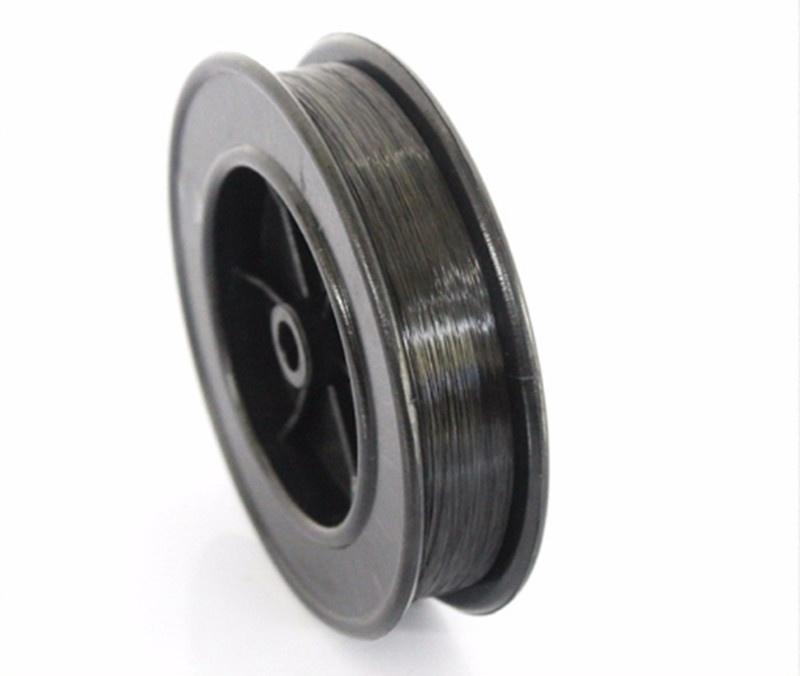Molybdenum has high melting point as same as tungsten but is easier to be processed. It is mainly used for high-temperature furnace parts, lighting, and electron tube. We have various wire diameters and finishing according to the application. We also offer special materials that have higher performance by adding trace elements (TEM),in our integrated production.Molybdenum Wire, also known as Moly Wire, is a refractory metal with a melting temperature of 4760℉. Our Molybdenum Wire is stocked & ready to ship.
Standard: ASTM B387
Material: Mo >99.95%
Density: >10.2g/cm3
Specifications
Our molybdenum wire is produced by stretching the Molybdenum rod to various diameter after the rod undergo the pass rolling and rotary forging to about 3mm. The Advantages of our molybdenum wire are with good stability, good tensile strength, high precision cutting and low elongation. Our factory can provide various of molybdenum wires with the diameter among 0.18~3.0mm, we can also provide custom products as your requirements. We offer 2,000 to 3,000 kg pure molybdenum wire products per month. Standard availability is described below. Other sizes and tolerances are available.
| Molybdenum Wire Types | Diameter (inch) | Tolerance (%) |
|---|---|---|
| Molybdenum Wire for EDM | 0.007" ~ 0.01" | ±3% wt |
| Molybdenum Spray Wire | 1/16" ~ 1/8" | ±1% to 3% wt |
| Molybdenum Wire | 0.002" ~ 0.08" | ±3% wt |
| Molybdenum Wire(clean) | 0.006" ~ 0.04" | ±3% wt |
Dimensions and Tolerances
Wire diameters are generally expressed in terms of inches or mils (thousandths of an inch). For thin wires from 0.001 inches up to 0.020 inches, the size of the wire is measured by weight per unit length. That is, the weight expressed in mg of a 200mm length of wire.
The standard diameter tolerance is ±3% of the weight measurement. For mandrel applications, the tolerance is normally ±1%.
Tensile Strength
Tensile strength for molybdenum wire is usually expressed in grams per milligram weight of a 200 millimeter length (or) g/mg/200mm. The normal range of values is 40 to 60 grams. In general, as tensile strength increases, wire straightness decreases.
Straightness
The measure of the straightness of a metal wire is obtained by cutting a ten inch long piece of wire and allowing it to lie on a flat clean surface. The maximum deviation from a straight line along its length is the quantitative measure of its straightness. In general, as the degree of the straightness increases, tensile strength decreases.
Quality and finish
The surface finish of wire is the black, as drawn condition, in which drawing lubricants and oxides are retained on the surface. Wire is also available in the cleaned condition, which is achieved through firing in hydrogen or electrochemical etching.
Spooling
Wire is spooled on clean, defect-free spools. Wire with large diameters is self-coiled. Spools are level-filled without piling near flanges.
Benefits
- Excellent Strength & Stiffness at high temperatures.
- High purity and excellent creep resistance.
- Good machinability and easily fabricated.
- High dimensional stability and excellent corrosion resistance
- Low emissivity and vapor pressure.
- Good electrical conductivity and low thermal expansion
- Ductile and corrosion resistant.
- Excellent Thermal conductivity.
Applications
- Hot Zones for high-temperature furnaces.
- Sputtering targets for coating solar cells & flat screens.
- Glass melting electrodes
- Heat shields
- Semiconductor base plates.
- Brazing fixtures & Boring bars
- Tools & Contacts
- Pigments and catalysts.
- Load bearing capabilities at temperatures up to 2000 °C,
- Excellent thermal and electrical conductivity
- Shielding from high energy particles

